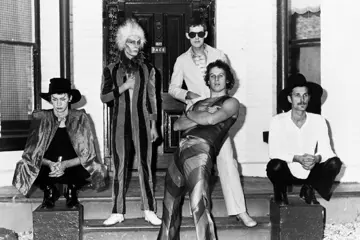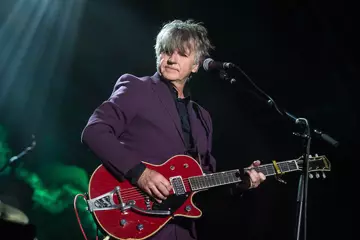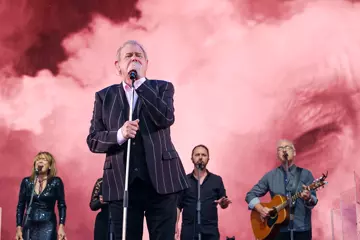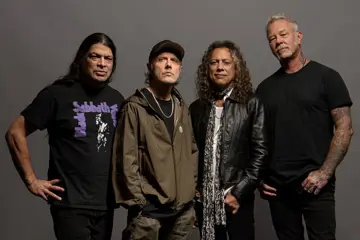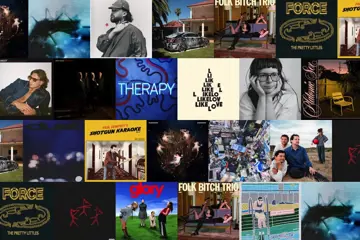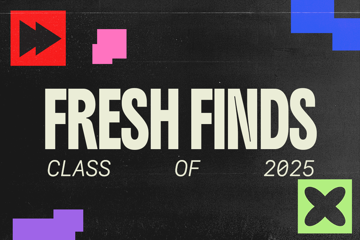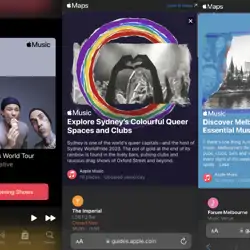 Apple Music
Apple MusicAs international analysts talk about a new era in music streaming, which will make more money for musicians, a new report says that Australian acts are facing a more challenging future.
This could be where Aussie acts have to plug into the global network and have a hit abroad before they are noticed here.
This is discussed in a new chapter in The Cambridge Companion to Music in Australia by University of Wollongong (UOW) researcher Dr Tim Byron and Dr Jadey O’Regan of the Sydney Conservatorium of Music.
The report, titled The Development of the Australian Pop Charts And The Changing Meaning Of The Number One Single, argues that it is a combination of how streaming services work and changes in how charts are compiled that focus on engagement rather than sales.
"In the past, they tracked sales of physical singles, but now they count how many times a song is streamed. This fundamental shift has changed what it means to have a number one hit,” said Dr Byron, a music and psychology expert in UOW’s School of Psychology.
Don't miss a beat with our FREE daily newsletter
“For an Australian act to get big in Australia in today’s climate, they usually have to get big internationally – in the new ecosystem, Australians only notice Australian acts if they have worldwide success.”
The authors say changes in the music landscape mean three key factors determine chart success. These are audience awareness, listener engagement and continued listening.
Because most Australian fans are consuming music through international streaming services which don’t prioritise local content, Dr Bryon adds, “In many ways it’s a shame to see the globalisation of the music charts because it means that young Australian audiences in 2025 just often don’t get exposed to Aussie music that might uniquely reflect their lives in a way that an international act never could.”
Problem
That’s not the only problem that Australian and global indie acts are facing, especially with those who are chasing sales solely in the Western – and particularly the US market.
The official figures indicate that the music streaming market is buoyant.
Two months ago, the London-based IFPI (International Federation of the Phonographic Industry) reported that global subscription revenue grew by 9.5 per cent to US$20 billion (AU $31 billion) and a 51.2 per cent share. Subscribers now number 752 million, and users 2 billion.
Last week, Universal Music Group unveiled that its subscription streaming revenue in the first quarter of 2025 grew 9.3 per cent year-on-year to reach €1.252 billion (AU $2 billion).
In the same quarter, Spotify celebrated a record all-time profit after growing its global Premium Subscriber base by an extra 5 million (up 12 per cent) to reach 268 million payers.
The picture looks rosy. But the insightful Mark Mulligan, CEO of UK-based MiDIA Research, says the reality is that 80 per cent of the new subscribers came from outside North America and Europe.
Instead, they were from the so-called Global South, or emerging music markets in Africa, the Middle East, Asia and Latin America.
Subscriber growth is slowing in the West. In the US, it went down from 29 per cent in 2019 to 25 per cent in 2020, to 11.3 per cent in 2021, to 9.1 per cent in 2022, to 5.7 per cent in 2023.
“Everybody knew this was coming, and this was the year where it really kicked into play,” Mulligan said in the Trapital entertainment industry podcast.
“If anything, it’s surprising that mature markets like the United States have been able to sustain growth at such a rate. But that’s a very Western view of the market and a very revenue view of the market.”
Mulligan noted that because music lovers in many of the emerging music markets have less disposable cash, despite the growth, their revenue is less than that of Western markets.
“The value of music is what people will pay for it. Right now, they will pay more for (video) streaming than music. You can only go so far with the average subscriber, and that point is when they start paying for it.”
Slowing Growth
To compensate for slowing growth and find new revenue sources, major labels like Universal Music Group are monetising superfans. Sony Music is putting the screw on streaming services to scrap free tiers and do more to prod users into ‘paying subscribers’ land.
Streaming services are either raising their prices or reducing them to give them ad-filled content. They’re cracking down on password-sharing and testing live sports.
They’re charging for what used to be. Spotify started to charge for song lyrics but drew a hasty retreat when users flung arrows their way. Tidal now charges $9 a month for DJ features.
A disturbing development from the artist-centric way of sharing royalties is that commercial acts seem to be benefiting more. Those with tens of millions of streams share in the pot. Technically, more indie acts and labels will see revenues up.
But tracks with less than 1,000 streams in the past 12 months are no longer considered to share in royalties. This, of course, hits indie artists and small labels hardest, said to be in their “thousands” on Spotify alone.
Luminate's year-end report for 2023 estimated that more than 158.6 million songs had 1,000 streams or less on Spotify that calendar year.
Spotify argues that these make up -0.5 per cent of total streams and therefore 0.5 per cent of its total pool. But given that the Swede’s royalty pool has expanded – $10 billion (AU $15.5 billion) in 2024 – it’s still a considerable figure.
It’s bad news for self-releasing artists. MIDiA estimated there are 8.2 million of these. The rate of their growth is 3.5 times faster than the growth of their royalties.
$500 Budget
Late last year, TheMusic.com.au exclusively reported on GYROstream’s Sound Check, which found that two-thirds of Australian and New Zealand artists have release budgets of no more than $500.
To keep within this spend, they opt for singles rather than EPs and albums, and make their own videos. 43 per cent of respondents considered content creation the “most potent promotional tool”, up from 27.3 per cent in 2023.
Revenue from global Artists Direct – self-releasing acts who release their work through the likes of CD Baby, DistroKid and TuneCore – rose 4.7 per cent year-on-year in 2024 to $2.2 billion (AU $3.4 billion). The rise was 4.5 per cent the year before.
Distributors and indie labels are more loudly expressing dissatisfaction with these lost royalties. 71 per cent of the latter are worried about the situation, from 64 per cent the prior year.
“One crucial element to keep an eye on is the long tail of independent artists,” said MIDiA’s Mulligan. “Measures like minimum earnings thresholds are taking a toll on Artists Direct revenue, and helping major labels throw speed bumps in the ongoing erosion of their market share.
“Yet it is doing nothing to halt the growth of releasing artists who compete for ears.”
The dilemma facing Australian self-releasing acts – and their international counterparts – is that they are advised at conferences to work harder. This means releasing more product more frequently so the algorithms don’t forget them and working social media more feverishly. But if their income keeps going down, they are in effect investing more for smaller returns.
There are ideas floating around to create new streaming models that are more sympathetic to indie names. Here are two:
Model One
US analyst John Darko came up with a model that was “a hybrid of Spotify, the iTunes store and Bandcamp — but without the downloads.”
It would have the 100 million songs found on Apple Music or Spotify.
The difference is there would be no monthly subscription fee. Instead, users would sign up to an account with an empty library but offered links to 30-second clip of a song. These can be chosen to stream.
“We can only stream what’s in our library,” Darko outlined. “And we can only add albums, EPs or ‘singles’ to our library by purchasing them.
“Doing so allows us to stream that release (or offline it inside the app) in perpetuity. Our choice of streaming quality: from 320kbps lossy to hi-res lossless.”
To buy a track, it would, in Australia, cost $1. “A flat fee, no matter the streaming quality or how many songs are contained therein. This would help keep the album-as-an-art-form alive and put a stop to one-track singles.”
The money pie would see artists and rights get 80 per cent to be divvied up depending on their contract, and the streaming service takes 20 per cent.
Model Two
MiDIA’s Mulligan’s vision is a more radical one. Rather than merely change existing systems, the idea would be to build from the ground up.
It would favour independent artists by giving them more control, fairer payment and wider revenues, more profile and quicker discoverability rather than having to compete with major names, and greater engagement with fans.
The key features of the Mulligan model are:
Human curating: rather than being dominated by algorithms, it would use humans to curate, in a way that music from indie acts and small labels will be more easily discovered.
Payment Per Stream: listeners will buy credits, each equating to one stream. This means a fixed per-stream payment and not the current system, where all payment goes into a pool and then are distributed unfairly.
More Money Making Options: the new model will make it easy for artists to earn through direct subscription, charging extra for exclusive content, tipping and selling merchandise.
Artists Decide Value: not all streams are worth the same. Here, the artist or label will decide whether to offer a track for free to promote their work or set a price of their choosing that their fans can pay. It could also allow fans to decide what they’ll pay.
Radio Experience: a free tier would see DJ programming exciting new tracks, remixes and demos.
The challenge of such an indie-focussed streaming service is that enough indie labels and artists must take the strength and pull out of the major services in droves (admittedly a frightening prospect) and pull their support behind this model in large numbers.
It would expect major support from listeners, who will pay per credit when they are used to the ease of just one monthly payment.
Most importantly, there must be enough investors out there to fund the expensive set-up of a model.



